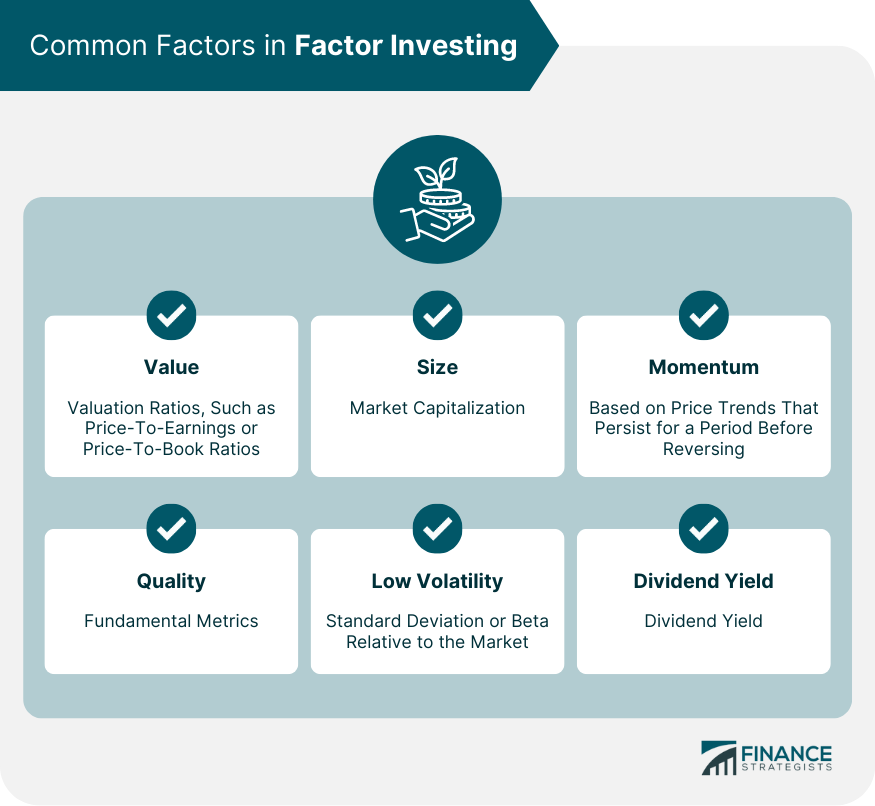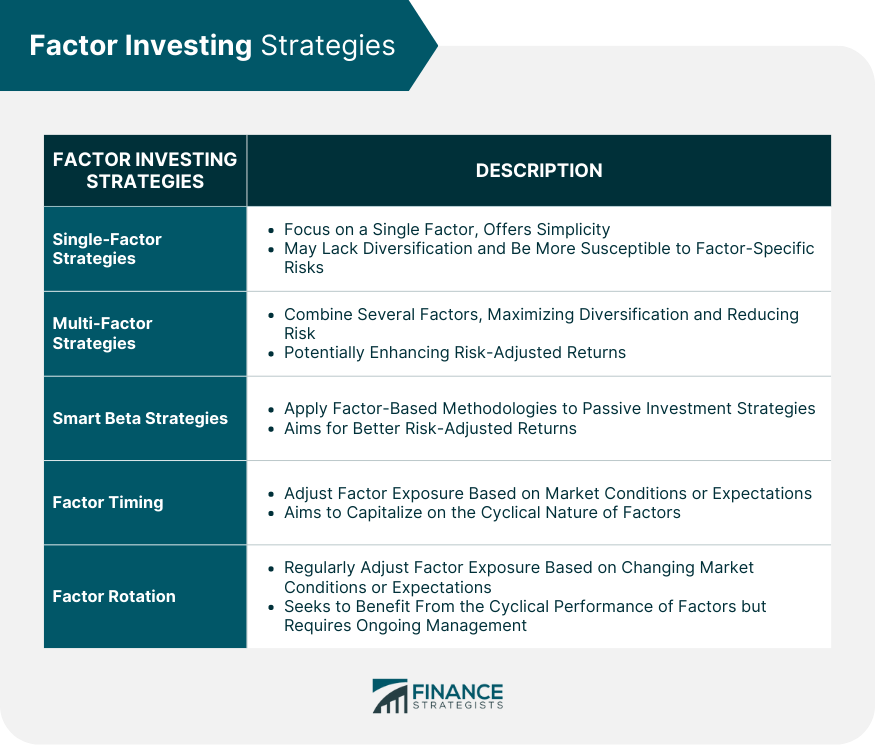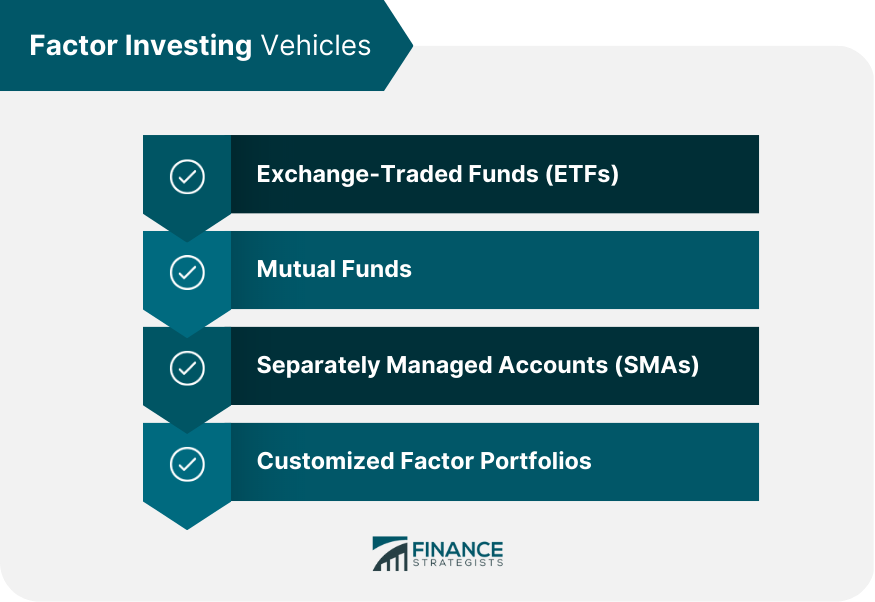Factor investing is an investment approach that targets specific characteristics, or factors, within securities to generate long-term risk-adjusted returns. It is based on the premise that certain factors consistently drive investment performance. The concept of factor investing originated in the 1960s with the development of the Capital Asset Pricing Model (CAPM). Subsequent research led to the identification of additional factors, such as value and size, contributing to the evolution of modern factor investing. Factor investing offers benefits such as improved portfolio diversification, risk management, and the potential for enhanced returns. However, it also carries risks, including factor crowding, changes in market regimes, and the possibility of underperformance. Value investing focuses on undervalued stocks, which are believed to offer higher returns compared to their overvalued counterparts. This factor is typically measured using valuation ratios, such as price-to-earnings or price-to-book ratios. The size factor targets smaller companies with the expectation that they may outperform larger ones over time. This is typically measured by market capitalization, with smaller-cap stocks offering potentially higher returns. Momentum investing seeks to capitalize on the tendency of securities that have recently outperformed to continue doing so in the short-term. This factor is based on the idea that price trends often persist for a period before reversing. Quality investing focuses on companies with strong fundamentals, such as profitability, low debt, and efficient management. These high-quality firms are believed to offer more stable and consistent returns compared to lower-quality companies. Low volatility investing targets stocks with lower price fluctuations, with the expectation that they will provide more stable returns and reduced risk. This factor is often measured using standard deviation or beta relative to the market. Dividend yield investing focuses on companies that pay high dividends relative to their stock price. This factor seeks to capture the potential for income generation and capital appreciation through dividend payouts. To construct a portfolio, single-factor strategies focus on a single factor, such as value or momentum. This approach offers simplicity and potential outperformance but may lack diversification and be more susceptible to factor-specific risks. Multi-factor strategies combine several factors in a single portfolio, maximizing diversification and reducing risk. These strategies seek to capitalize on the complementary nature of certain factors, potentially enhancing risk-adjusted returns. Smart beta strategies apply factor-based methodologies to passive investment strategies like index funds. They aim to achieve better risk-adjusted returns by targeting specific factors while maintaining a diversified, low-cost portfolio. Factor timing involves adjusting exposure to specific factors based on market conditions or expectations. This strategy aims to capitalize on the cyclical nature of factors, but it requires accurate forecasting, which can be challenging. Factor rotation involves regularly adjusting factor exposure within a portfolio based on changing market conditions or expectations. This approach seeks to benefit from the cyclical performance of factors but requires ongoing monitoring and active management. Factor-based ETFs provide a convenient and cost-effective way to access factor investing strategies. They offer transparency, liquidity, and diversification, making them a popular choice for investors seeking factor exposure. Factor-based mutual funds offer actively managed portfolios targeting specific factors. They provide professional management and diversification but may have higher fees compared to ETFs. Separately managed accounts offer customized factor investing solutions tailored to individual investors' needs and preferences. SMAs provide personalized portfolio management and factor exposure, but they may require higher minimum investments and have higher fees compared to ETFs and mutual funds. Customized factor portfolios allow investors to build their own factor-based strategies by selecting individual stocks or other securities. This approach offers greater control and flexibility but requires extensive research and ongoing monitoring to manage factor exposure and risks. Before implementing factor investing, it is crucial to identify individual investor goals and risk tolerance. Understanding one's objectives and risk appetite helps in selecting appropriate factors and strategies that align with personal financial goals. Assessing factor exposure in an existing portfolio helps identify potential gaps and redundancies. A thorough evaluation enables investors to make informed decisions about adjusting their portfolio to achieve desired factor exposure and balance. Choosing the right factors and strategies is critical to the success of factor investing. Investors should consider factors that complement their existing portfolio, align with their goals and risk tolerance, and have demonstrated long-term performance. Constructing a well-diversified portfolio is essential to manage risk in factor investing. By combining multiple factors, investors can reduce the impact of any single factor underperforming and potentially enhance risk-adjusted returns. Regular performance monitoring and adjustments are vital to the success of factor investing. This ongoing process enables investors to identify underperforming factors, make necessary changes, and maintain alignment with their financial goals. Factor crowding occurs when too many investors adopt the same factor strategy, potentially reducing its effectiveness. Crowded factors may experience diminished returns and increased volatility, affecting overall portfolio performance. Factor persistence refers to the long-term reliability of a factor's ability to generate excess returns. Some factors may not maintain their performance over time, which can negatively impact the effectiveness of a factor investing strategy. Model overfitting occurs when a factor investing strategy is tailored too closely to historical data, potentially reducing its effectiveness in future market conditions. Overfitting can lead to poor performance and increased risk when market dynamics change. Data mining refers to the practice of sifting through vast amounts of data to identify patterns that may not hold up in future market conditions. The risk of data mining can lead to factor investing strategies based on spurious relationships, negatively affecting performance. Market regime changes, such as shifts in economic conditions or investor sentiment, can affect factor performance. These changes may lead to underperformance of certain factors and require investors to adjust their strategies to maintain portfolio balance and achieve desired returns. Factor investing is increasingly important in modern portfolio management, offering a systematic and evidence-based approach to generating risk-adjusted returns. By targeting specific factors, investors can enhance diversification, manage risk, and potentially improve performance. Understanding the risks and benefits associated with each factor is essential for successful factor investing. Investors should be aware of potential challenges, such as factor crowding and persistence, and make informed decisions to manage risk and achieve their financial goals. Continued research and evaluation are crucial to the evolution and success of factor investing. As market conditions and investor preferences change, ongoing research can help identify new factors, refine existing strategies, and improve overall portfolio management. Considering the complexities of factor investing, seeking the guidance of professional wealth management services can be highly beneficial. These experts can help navigate the challenges, tailor strategies to individual goals, and provide ongoing support to optimize portfolio performance. What Is Factor Investing?
Common Factors in Factor Investing
Value
Size
Momentum
Quality
Low Volatility
Dividend Yield

Factor Investing Strategies
Single-Factor Strategies
Multi-Factor Strategies
Smart Beta Strategies
Factor Timing
Factor Rotation

Factor Investing Vehicles
Exchange-Traded Funds (ETFs)
Mutual Funds
Separately Managed Accounts (SMAs)
Customized Factor Portfolios

Implementing Factor Investing
Identifying Individual Investor Goals and Risk Tolerance
Assessing Factor Exposure in Current Portfolio
Selecting Appropriate Factors and Strategies
Portfolio Construction and Diversification
Performance Monitoring and Adjustments
Factor Investing Challenges and Limitations
Factor Crowding
Factor Persistence
Model Overfitting
Data Mining Concerns
Market Regime Changes
Final Thoughts
Factor Investing FAQs
Factor investing is an investment approach that targets specific characteristics, or factors, within securities to generate long-term risk-adjusted returns. It offers benefits such as improved portfolio diversification, risk management, and the potential for enhanced returns. However, it also carries risks, including factor crowding, changes in market regimes, and the possibility of underperformance.
The common factors in factor investing include value, size, momentum, quality, low volatility, and dividend yield. These factors are used to construct portfolios that target specific characteristics within securities.
The different factor investing strategies include single-factor strategies, multi-factor strategies, smart beta strategies, factor timing, and factor rotation. Each strategy has its own advantages and disadvantages, and investors should carefully consider their goals and risk tolerance before choosing a strategy.
The factor investing vehicles available to investors include exchange-traded funds (ETFs), mutual funds, separately managed accounts (SMAs), and customized factor portfolios. Each vehicle has its own advantages and disadvantages, and investors should choose one that aligns with their goals and preferences.
The challenges and limitations of factor investing include factor crowding, factor persistence, model overfitting, data mining concerns, and market regime changes. Investors should be aware of these potential challenges and make informed decisions to manage risk and achieve their financial goals. Seeking the guidance of professional wealth management services can also be highly beneficial.
True Tamplin is a published author, public speaker, CEO of UpDigital, and founder of Finance Strategists.
True is a Certified Educator in Personal Finance (CEPF®), author of The Handy Financial Ratios Guide, a member of the Society for Advancing Business Editing and Writing, contributes to his financial education site, Finance Strategists, and has spoken to various financial communities such as the CFA Institute, as well as university students like his Alma mater, Biola University, where he received a bachelor of science in business and data analytics.
To learn more about True, visit his personal website or view his author profiles on Amazon, Nasdaq and Forbes.















